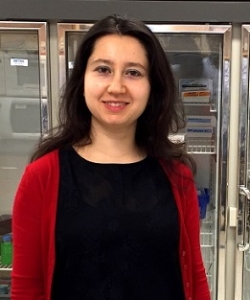Success of Yildirim Family

Mihriban Yıldırım, a researcher in genetics at the Massachusetts General Hospital, uncovers unanticipated biological principles dictating poor outcomes in triple-negative breast cancer (TNBC) via single-cell RNA sequencing. Her husband, Murat Yildirim, a researcher at the Massachusetts Institute of Technology (MIT), developed a microscope that can reveal first look through all cortical layers of the awake brain. Their work has been both published in Nature Communications recently.
Triple-negative breast cancer (TNBC) is an aggressive subtype characterized by extensive intratumoral heterogeneity. To investigate the underlying biology, Mihriban Yildirim and her colleagues conducted single-cell RNA-sequencing (scRNA-seq) of >1500 cells from six primary TNBC. Here, they show that intercellular heterogeneity of gene expression programs within each tumor is variable and largely correlates with clonality of inferred genomic copy number changes, suggesting that genotype drives the gene expression phenotype of individual subpopulations. Clustering of gene expression profiles identified distinct subgroups of malignant cells shared by multiple tumors, including a single subpopulation associated with multiple signatures of treatment resistance and metastasis, and characterized functionally by activation of glycosphingolipid metabolism and associated innate immunity pathways. A novel signature defining this subpopulation predicts long-term outcomes for TNBC patients in a large cohort. Collectively, this analysis reveals the functional heterogeneity and its association with genomic evolution in TNBC and uncovers unanticipated biological principles dictating poor outcomes in this disease.
 In his paper, Murat Yildirim and his colleagues can record evoked neuronal activity in all cortical layers as well as subplate of primary visual cortex (V1) of awake mice with optimizing 3-photon microscopy. Their measurements of physiological responses and tissue-damage thresholds define pulse parameters and safety limits for damage-free three-photon imaging. They image functional visual responses of neurons expressing GCaMP6s across all layers of the primary visual cortex (V1) and in the subplate. These recordings reveal diverse visual selectivity in deep layers: layer 5 neurons are more broadly tuned to visual stimuli, whereas mean orientation selectivity of layer 6 neurons is slightly sharper, compared to neurons in other layers. Subplate neurons, located in the white matter below cortical layer 6 and characterized here for the first time, show low visual responsivity and broad orientation selectivity. Subplate neurons are among the earliest born neurons of the cerebral cortex and are considered to be largely transient neurons necessary for the development of cortical connections and circuits. In addition, subplate neurons have been implicated in brain abnormalities including epilepsy, and neurodevelopmental disorders including autism and schizophrenia.
In his paper, Murat Yildirim and his colleagues can record evoked neuronal activity in all cortical layers as well as subplate of primary visual cortex (V1) of awake mice with optimizing 3-photon microscopy. Their measurements of physiological responses and tissue-damage thresholds define pulse parameters and safety limits for damage-free three-photon imaging. They image functional visual responses of neurons expressing GCaMP6s across all layers of the primary visual cortex (V1) and in the subplate. These recordings reveal diverse visual selectivity in deep layers: layer 5 neurons are more broadly tuned to visual stimuli, whereas mean orientation selectivity of layer 6 neurons is slightly sharper, compared to neurons in other layers. Subplate neurons, located in the white matter below cortical layer 6 and characterized here for the first time, show low visual responsivity and broad orientation selectivity. Subplate neurons are among the earliest born neurons of the cerebral cortex and are considered to be largely transient neurons necessary for the development of cortical connections and circuits. In addition, subplate neurons have been implicated in brain abnormalities including epilepsy, and neurodevelopmental disorders including autism and schizophrenia.
Mihriban Yildirim received her undergraduate degree in molecular biology and genetics from Bilkent University. Then, she obtained her Ph.D. from Stony Brook University, where she studied the role of microRNAs in cancer and discovered a novel microRNA targeting BCL2 and increasing the cytotoxic effect of 5-fluorouracil. Dr. Yildirim has a longstanding interest in breast cancer biology and prevention and is currently a postdoctoral fellow at the Mass General Cancer Center/Harvard Medical School in the laboratory of Dr. Leif W. Ellisen. Dr. Mihriban Yildirim received prestigious postdoctoral fellowships from Terri Brodeur and Susan G. Komen foundations.
Murat Yildirim received the undergraduate and master degrees in mechanical engineering from Middle East Technical University. Then, he joined the University of Texas at Austin to perform his doctoral studies. In his doctoral studies, he developed bench-top and endoscopic multiphoton systems to perform nonlinear imaging-guided femtosecond laser surgery to treat vocal fold scarring. After receiving his PhD, he came to MIT to establish a joint project between Mriganka Sur and Peter So for developing two- and three-photon microscopes to image and manipulate neurons in awake animal models.
For further details: Mihriban Yildirim’s paper; Murat Yildirim’s paper & video